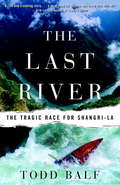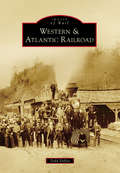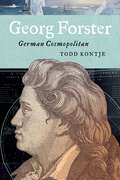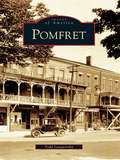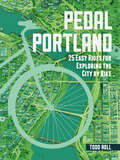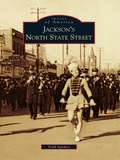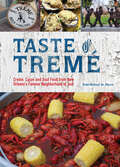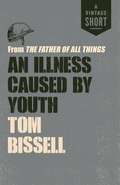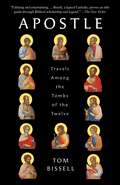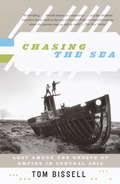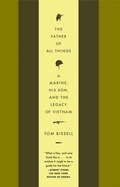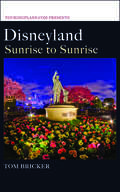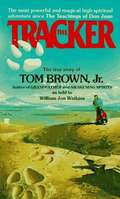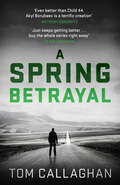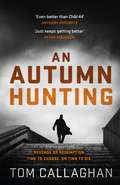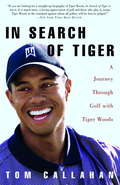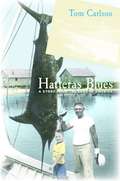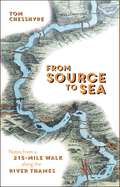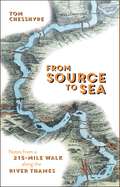- Table View
- List View
The Last River
by Todd BalfIt was the ultimate whitewater adventure on the Mount Everest of rivers, and the biggest challenge of their lives....October 1998 an American whitewater paddling team traveled deep into the Tsangpo Gorge in Tibet to run the Yarlung Tsangpo, known in paddling circles as the "Everest of rivers." On Day 12 of that trip, the team's ace paddler, one of four kayakers on the river, launched off an eight-foot waterfall and flipped. He and his overturned kayak spilled into the heart of the thunderous "freight training" river and were swept downstream, never to be seen again.The Last River: The Tragic Race for Shangri-la is a breathtaking account of this ill-fated expedition, a fascinating exploration of what propelled these kayakers to take on the seething big water and perilous Himalayan terrain of the deepest gorge on the planet. This was the magical Shangri-la of legend, a 140-mile-long canyon framed by 25,000-foot snowcapped peaks, a place of unimaginable beauty called Pemako in ancient Buddhist texts that was rumored to contain mammoth waterfalls. At the close of the twentieth century, an end-to-end descent of the gorge filled the imaginations of some of the best boaters in the world, who saw in the foam and fury of the Tsangpo's rapids the ultimate whitewater challenge. For Wick Walker and Tom McEwan, extreme whitewater pioneers, best friends, and trip leaders, the Tsangpo adventure with Doug Gordon, Olympic medal-winning paddler Jamie McEwan (Tom's brother), and Roger Zbel was the culmination of a twenty-five-year quest. Fueled by narratives of early explorers, Walker and McEwan kept their dream alive and waited until the Chinese government opened the gorge to Westerners. With financial backing from the National Geographic Society, the group was finally good to go in 1998. Swollen to three times the size they had expected because of record rains and heavy snowmelt, the Tsangpo lived up to its fearsome reputation. On numerous occasions the team questioned whether to continue, but chose to press forward. The Last River probes beyond the extreme sports clichés and looks at the complex personal and intellectual reasons for the seemingly irresistible draw of Tibet's Great River. For Walker, Gordon, Zbel, and the McEwans -- husbands, fathers, friends, and brothers -- the Tsangpo wasn't a run toward death but a celebration of life, adventure, and the thing that tied them to one another -- awe-inspiring rivers. The Last River is also a riveting journey to one of the world's wildest and most alluring places, a thrilling book that invites us into the Himalayas of Jon Krakauer's classic, Into Thin Air, but from a totally new perspective -- on a historic river so remote that only the most hardy and romantic souls attempt to unlock its mysteries. Visit www.randomhouse.com/features/lastriverFrom the Hardcover edition.
Western & Atlantic Railroad (Images of Rail)
by Todd DeFeoThe State of Georgia chartered the Western & Atlantic Railroad in 1836. The railroad aided in the development and growth of many communities between Atlanta and Chattanooga, Tennessee. In constructing the railroad, workers created a winding route that cut its way across the North Georgia landscape. During the Civil War, both armies used this vital artery, and it was the setting for one of the war's most iconic events, the Great Locomotive Chase. The state still owns the Western & Atlantic and has leased it since 1870. The line remains an essential part of North Georgia and is a backbone of the region's industry. As Atlanta ponders its transportation future, it is important to remember that without the Western & Atlantic, Atlanta would not be the city it is today.
Three Years in Wonderland: The Disney Brothers, C. V. Wood, and the Making of the Great American Theme Park
by Todd James PierceWhile the success of Disneyland is largely credited to Walt and Roy Disney, there was a third, mostly forgotten dynamo instrumental to the development of the park—fast-talking Texan C. V. Wood. Three Years in Wonderland presents the never-before-told, full story of “the happiest place on earth.” Using information from over one hundred unpublished interviews, Todd James Pierce lays down the arc of Disneyland's development from an idea to a paragon of entertainment. In the early 1950s, the Disney brothers hired Wood and his team to develop a feasibility study for an amusement park that Walt wanted to build in southern California. “Woody” quickly became a central figure. In 1954, Roy hired him as Disneyland's first official employee, its first general manager, and appointed him vice president of Disneyland, Inc., where Walt’s authority only exceeded Wood’s authority. A brilliant project manager, Wood was also a con artist of sorts. Previously, he had forged his university diploma. A smooth-talker drawn to Hollywood, the first general manager of Disneyland valued money over art. As relations soured between Wood and the Disney brothers, Wood found creative ways to increase his income, leveraging his position for personal fame. Eventually, tensions at the Disney park reached a boiling point, with Walt demanding Wood be fired. In compelling detail, Three Years in Wonderland lays out the struggles and rewards of building the world's first cinematic theme park and convincing the American public that a $17 million amusement park was the ideal place for a family vacation. The early experience of Walt Disney, Roy Disney, and C. V. Wood is one of the most captivating untold stories in the history of Hollywood. Pierce interviewed dozens of individuals who enjoyed long careers at the Walt Disney Company as well as dozens of individuals who—like C. V. Wood—helped develop the park but then left the company for good once the park opened. Through much research and many interviews, Three Years in Wonderland offers readers a rare opportunity to stand shoulder-to-shoulder with the people who built the best-known theme park in the world.
Georg Forster: German Cosmopolitan (Max Kade Research Institute)
by Todd KontjeGeorg Forster (1754–1794) was famous during his lifetime, notorious after his death, and largely forgotten by the later nineteenth century. Remembered today as the young man who sailed around the world with Captain Cook and as one of the leading figures in the revolutionary Republic of Mainz, Forster was also a prolific writer and translator who left behind two travelogues, a series of essays on diverse topics, and numerous letters. This in-depth look at Forster’s work and life reveals his importance for other writers of the age. Todd Kontje traces the major intellectual themes and challenges found in Forster’s writings, interweaving close textual analysis with his rich but short life. Each chapter engages with themes that reflect the current debates in eighteenth-century literary and cultural studies, including changing notions of authorship, multilingualism, the representation of so-called primitive societies, Enlightenment ideas about race, and early forms of ecological thinking. As Kontje shows, Forster’s peripatetic life, malleable sense of national identity, and fluency in multiple languages contrast with the image of the solitary genius in the “age of Goethe.” In this way, Forster provides a different model of authorship and citizenship better understood in the context of an increasingly globalized world.Compellingly argued and engagingly written, this book restores Forster to his rightful place within the German literary tradition, and in so doing, it urges us to reconsider the age of Goethe as multilingual and malleable, local and cosmopolitan, dynamic and decentered. It will be welcomed by specialists in German studies and the Enlightenment.
Pomfret (Images of America)
by Todd LangworthyWhen shipbuilder Zattu Cushing passed through western New York State at the beginning of the 19th century, he saw a beautiful area that had great potential for settlement. He vowed to come back and settle with his family as soon as possible. In 1805, Cushing came back and became the first permanent settler in what was to become the town of Pomfret. Pomfret quickly grew, attracting people of great talent to the small settlement situated on Canadaway Creek near Lake Erie. Soon the village of Fredonia was chartered within the town, leading to even more fantastic growth. Pomfret became a town of many firsts, as well as the home of countless noteworthy families. Today Pomfret is a vibrant community that is proud of its past and excited about its future.
Pedal Portland: 25 Easy Rides for Exploring the City by Bike
by Todd RollPedal Portland is the ultimate guide for riding like a local. Portland is beautiful, and the ever-expanding bike infrastructure makes for safe and pleasant riding. And it is a city full of bicyclists: 40 percent of residents bike recreationally and nearly 10 percent commute daily on bike. No wonder Bicycling magazine regularly names it one of the top cities to bike in America!Pedal Portland celebrates the city’s passion for pedaling in an accessible, fun, and family-friendly way with rides that explore the most interesting parts of the city, from north to northwest to northeast, southwest to southeast, and the surrounding areas like Beaverton and Vancouver. The rides are accessible to anyone with a bike and range from eight to twelve miles but can be shortened by taking advantage of the city’s bike-friendly public transportation. Each route features a scavenger hunt that highlights the quirky and interesting sites along the way and includes tips on where to eat, drink, and stop to appreciate the view.
Jackson's North State Street (Images of America)
by Todd SandersSince the mid-19th and early 20th centuries, Jackson's North State Street has been home to some of the capital city's major architectural landmarks. North State Street was bordered by stately homes of many different styles and periods, from rather simple antebellum cottages, to grand Greek Revival, elaborate Queen Anne, and elegant Colonial Revival and neoclassical mansions, as well as impressive institutional buildings and churches. However, beginning in the early years of the Great Depression, many of these stately homes and buildings were lost, replaced by apartments, parking lots, and commercial buildings. Through the images in this book, those who never witnessed first hand the majesty of Jackson's North State Street will be able to gain some insight into what has been lost and truly appreciate what remains. For those who remember what North State Street was, this book will be a chance to revisit and reminisce about that lost era.
Taste of Tremé: Creole, Cajun, and Soul Food from New Orleans' Famous Neighborhood of Jazz
by Todd-Michael St. Pierre“Stuffed with doable recipes, from breakfast right on through to dinner, dessert, and cocktails . . . packed with the flavor and soul of the city.” —The Christian Science MonitorIn Tremé, jazz is always in the air and something soulful is simmering on the stove. This gritty neighborhood celebrates a passion for love, laughter, friends, family and strangers in its rich musical traditions and mouth-watering Southern food. Infuse your own kitchen with a Taste of Tremé by serving up its down-home dishes and new twists on classic New Orleans favorites like:Muffuletta SaladChargrilled OystersCrawfish and Corn BeignetsShrimp and Okra HushpuppiesChicken and Andouille GumboRoast Beef Po’ BoyCreole Tomato Shrimp JambalayaBananas FosterIncluding fascinating cultural facts about the music, architecture and dining that make up Tremé, this book will have your taste buds tapping to the beat of a big brass band.“Explores one of the most famous neighborhoods of New Orleans through recipes, photographs, vignettes, and quotations . . . a celebration of everything that New Orleans has to offer, including food, music, architecture, and more.” —FaveSouthernRecipes
Grey Skies, Green Waves: A Surfer's Journey Around the UK and Ireland
by Tom AndersonTom Anderson has always loved surfing – anywhere except the UK. But a chance encounter leads him to a series of adventures on home surf… As he visits the popular haunts and secret gems of British surfing he rekindles his love affair with the freezing fun that is surfing the North Atlantic.
Grey Skies, Green Waves: A Surfer's Journey Around the UK and Ireland
by Tom AndersonTom Anderson has always loved surfing – anywhere except the UK. But a chance encounter leads him to a series of adventures on home surf… As he visits the popular haunts and secret gems of British surfing he rekindles his love affair with the freezing fun that is surfing the North Atlantic.
An Illness Caused by Youth: from The Father of All Things
by Tom BissellVeteran Jack Bissell only deepened the abyss between him and his son Tom when he talked about the Vietnam war. But, when a magazine editor sends the two back to Vietnam for a story, Tom reopens the conversation and confronts his father’s past and the man that had seemed impossibly remote. Part history, memoir, and travelogue, Tom Bissell’s is a haunting, riveting exploration of the war’s personal, political, and cultural impact from the perspective of the generation that grew up in the wake of the conflict and a wise reckoning of the bond forged between fathers and sons. A Vintage Shorts Vietnam Selection. An ebook short.
Apostle
by Tom BissellA profound and moving journey into the heart of Christianity that explores the mysterious and often paradoxical lives and legacies of the Twelve Apostles--a book both for those of the faith and for others who seek to understand Christianity from the outside in. Peter, Matthew, Thomas, John: Who were these men? What was their relationship to Jesus? Tom Bissell provides rich and surprising answers to these ancient, elusive questions. He examines not just who these men were (and weren't), but also how their identities have taken shape over the course of two millennia. Ultimately, Bissell finds that the story of the apostles is the story of early Christianity: its competing versions of Jesus's ministry, its countless schisms, and its ultimate evolution from an obscure Jewish sect to the global faith we know today in all its forms and permutations. In his quest to understand the underpinnings of the world's largest religion, Bissell embarks on a years-long pilgrimage to the supposed tombs of the Twelve Apostles. He travels from Jerusalem and Rome to Turkey, Greece, Spain, France, India, and Kyrgyzstan, vividly capturing the rich diversity of Christianity's worldwide reach. Along the way, he engages with a host of characters--priests, paupers, a Vatican archaeologist, a Palestinian taxi driver, a Russian monk--posing sharp questions that range from the religious to the philosophical to the political. Written with warmth, empathy, and rare acumen, Apostle is a brilliant synthesis of travel writing, biblical history, and a deep, lifelong relationship with Christianity. The result is an unusual, erudite, and at times hilarious book--a religious, intellectual, and personal adventure fit for believers, scholars, and wanderers alike.From the Hardcover edition.
Apostle: Travels Among the Tombs of the Twelve
by Tom BissellA profound and moving journey into the heart of Christianity that explores the mysterious and often paradoxical lives and legacies of the Twelve Apostles—a book both for those of the faith and for others who seek to understand Christianity from the outside in.“Expertly researched and fascinating… Bissell is a wonderfully sure guide to these mysterious men.… This is a serious book about the origins of Christianity that is also very funny. How often can you say that?” —The Independent Peter, Matthew, Thomas, John: Who were these men? What was their relationship to Jesus? Tom Bissell provides rich and surprising answers to these ancient, elusive questions. He examines not just who these men were (and weren’t), but also how their identities have taken shape over the course of two millennia. Ultimately, Bissell finds that the story of the apostles is the story of early Christianity: its competing versions of Jesus’s ministry, its countless schisms, and its ultimate evolution from an obscure Jewish sect to the global faith we know today in all its forms and permutations. In his quest to understand the underpinnings of the world’s largest religion, Bissell embarks on a years-long pilgrimage to the supposed tombs of the Twelve Apostles. He travels from Jerusalem and Rome to Turkey, Greece, Spain, France, India, and Kyrgyzstan, vividly capturing the rich diversity of Christianity’s worldwide reach. Along the way, he engages with a host of characters—priests, paupers, a Vatican archaeologist, a Palestinian taxi driver, a Russian monk—posing sharp questions that range from the religious to the philosophical to the political. Written with warmth, empathy, and rare acumen, Apostle is a brilliant synthesis of travel writing, biblical history, and a deep, lifelong relationship with Christianity. The result is an unusual, erudite, and at times hilarious book—a religious, intellectual, and personal adventure fit for believers, scholars, and wanderers alike.From the Hardcover edition.
Chasing the Sea
by Tom BissellIn 1996, Tom Bissell went to Uzbekistan as a na*ve Peace Corps volunteer. Though he lasted only a few months before illness and personal crisis forced him home, Bissell found himself entranced by this remote land. Five years later he returned to explore the shrinking Aral Sea, destroyed by Soviet irrigation policies. Joining up with an exuberant translator named Rustam, Bissell slips more than once through the clutches of the Uzbek police as he makes his often wild way to the devastated sea.In Chasing the Sea, Bissell combines the story of his travels with a beguiling chronicle of Uzbekistan's striking culture and long history of violent subjugation by despots from Jenghiz Khan to Joseph Stalin. Alternately amusing and sobering, this is a gripping portrait of a fascinating place, and the debut of a singularly gifted young writer.
The Father of All Things
by Tom BissellThe Father of All Things is a riveting, haunting, and often hilarious account of a veteran and his son's journey through Vietnam. As his father recounts his experiences as a soldier, including a near fatal injury, Tom Bissell weaves a larger history of the war and explores the controversies that still spark furious debate today. Blending history, memoir, and travelogue,The Father of All Things is a portrait of the war's personal, political, and cultural impact from the perspective of the generation that grew up in the wake of the conflict. It is also a wise and revelatory book about the bond between fathers and sons.
Disneyland: Sunrise to Sunrise
by Tom BrickerDisneyland: Sunrise to Sunrise is a collection of more than 200 photos from one single operational day in Disneyland, specifically "One More Disney Day," which was an event on Leap Day 2012 at Disneyland. On "One More Disney Day," Disneyland was open 24 consecutive hours. Tom captured all of the photos in the eBook during the course of that morning, day, night, and second morning. In so doing, Tom was one of the crazy Disneyland guests in the park on "One More Disney Day" from start to the very finish snapping hundreds of photos along the way to document the day.Disneyland: Sunrise to Sunrise highlights some of the best photos that Tom captured on that single operational day in Disneyland and presents them in one attractive eBook. Throughout the book Tom presents tidbits of trivia, such as the inspiration for the original Tomorrowland Moonliner and why Snow White was ultimately added to Snow White's Scary Adventures attraction in Fantasyland. If you're a fan of the Disney theme parks, you'll enjoy this fresh and beautiful look at one day in Disneyland.
The Tracker: The Story of Tom Brown, Jr. as told to William Jon Watkins
by Tom BrownA true story of survival from one of America's most respected outdoorsman. "The first track is the end of a string. At the far end, a being is moving; a mystery, dropping a hint about itself every so many feet, telling you more about itself until you can almost see it, even before you come to it. The mystery reveals itself slowly, track by track, giving its genealogy early to coax you in. Further on, it will tell you the intimate details of its life and work, until you know the maker of the track like a lifelong friend." In this powerful memoir, famous "Pine Barrens" tracker Tom Brown Jr. reveals how he acquired the skill that has saved dozens of lives—including his own. His story begins with the chance meeting between an ancient Apache and a New Jersey boy. It tells of an incredible apprenticeship in the Wild, learning all that is hidden from modern man. And it ends with a harrowing search in which far more than survival is at stake.
A Spring Betrayal: An Inspector Akyl Borubaev Thriller (2)
by Tom Callaghan'Even better than Child 44. Akyl Borubaev is a terrific creation' Anthony HorowitzWE UNCOVERED THE LAST OF THE BODIES IN THE RED HOUR BEFORE DUSK, AS THE SUN STAINED THE SNOWCAPS OF THE TIAN SHAN MOUNTAINS THE COLOUR OF DRIED BLOOD. . .Inspector Akyl Borubaev of Bishkek Murder Squad has been exiled to the far corner of Kyrgyzstan, but death still haunts him at every turn. Borubaev soon finds himself caught up in a mysterious and gruesome new case: several children's bodies have been found buried together - all tagged with name bands. In his search for the truth behind the brutal killings, Borubaev hits a wall of silence, with no one to turn to outside his sometime lover, the beautiful undercover agent Saltanat Umarova.When Borubaev himself is framed, accused of involvement in the production of blood-soaked child pornography, it looks as though things couldn't get any worse. With the investigation at a dangerous standstill, Borubaev sets out to save his own integrity, and to deliver his own savage justice on behalf of the many dead who can't speak for themselves . . .'Just keeps getting better . . . buy the whole series right away' Peter Robinson, No.1 bestselling author of Sleeping in the Ground'Storytelling of the highest quality . . . Introduces a detective it is impossible not to believe in. Callaghan is a new voice to be welcomed' Daily Mail
A Spring Betrayal: An Inspector Akyl Borubaev Thriller (2) (An Inspector Akyl Borubaev Thriller)
by Tom Callaghan'Even better than Child 44. Akyl Borubaev is a terrific creation' Anthony HorowitzWE UNCOVERED THE LAST OF THE BODIES IN THE RED HOUR BEFORE DUSK, AS THE SUN STAINED THE SNOWCAPS OF THE TIAN SHAN MOUNTAINS THE COLOUR OF DRIED BLOOD. . .Inspector Akyl Borubaev of Bishkek Murder Squad has been exiled to the far corner of Kyrgyzstan, but death still haunts him at every turn. Borubaev soon finds himself caught up in a mysterious and gruesome new case: several children's bodies have been found buried together - all tagged with name bands. In his search for the truth behind the brutal killings, Borubaev hits a wall of silence, with no one to turn to outside his sometime lover, the beautiful undercover agent Saltanat Umarova.When Borubaev himself is framed, accused of involvement in the production of blood-soaked child pornography, it looks as though things couldn't get any worse. With the investigation at a dangerous standstill, Borubaev sets out to save his own integrity, and to deliver his own savage justice on behalf of the many dead who can't speak for themselves . . .'Just keeps getting better . . . buy the whole series right away' Peter Robinson, No.1 bestselling author of Sleeping in the Ground'Storytelling of the highest quality . . . Introduces a detective it is impossible not to believe in. Callaghan is a new voice to be welcomed' Daily Mail
An Autumn Hunting
by Tom Callaghan'Even better than Child 44. Akyl Borubaev is a terrific creation' Anthony Horowitz'Just keeps getting better . . . buy the whole series right away' Peter Robinson, No.1 bestselling author of Sleeping in the GroundNo sooner has Akyl Borubaev been reinstated as an Inspector in the Bishkek Murder Squad than he's suspended for alleged serious crimes against the state. After an attempted assassination of a prominent minister goes spectacularly wrong, Akyl is a fugitive from his former colleagues and involved with one of Kyrgyzstan's most dangerous criminals. On the run, caught up in a illegal scheme that can only end badly, it's time for Akyl to take a stand for everything he believes in.
In Search of Tiger: A Journey Through Golf with Tiger Woods
by Tom CallahanTom Callahan has written the seminal book on golfing great Tiger Woods. Woods, who has gone out of his way to protect his privacy, has never allowed himself to get close enough to a writer to be properly examined on the page. Callahan, commonly regarded as one of the best all-round sports writers in the country, has followed Tiger around the world of golf for more than seven years, enjoying a certain access to the man and his family. He even went so far as to travel to Vietnam to learn the fate of the South Vietnamese soldier who was Earl Wood's best friend during the war - and his son's namesake. Tiger is twenty years old when the book opens and twenty-seven when it closes. During those years, Callahan covered Woods at all the Majors, including the Masters, the U. S. Open, and the British Open, culminating in Tiger's heart-stopping race to make history by clinching the string of Majors affectionately nicknamed the Tiger Slam. Along the way, Tom Callahan hears from everyone who is anyone in the world of Tiger Woods, including Phil Mickelson, Jack Nicklaus, David Duval, Butch Harmon, Ernie Els, and, of course, Tiger's rather ubiquitous mother and father. As much as we learn about Tiger - how he sees himself in relation to the courses he plays on and the players he has learned from and competed with - we also enjoy a bird's-eye view of golf as it is now with Tiger on the scene, and as it was for centuries before.
Hatteras Blues
by Tom CarlsonTom Carlson tells the story of Ernal Foster and the Foster family of Hatteras Village, who gave birth to what would become the multi-million dollar charter fishing industry on the Outer Banks. Today, Ernal's son, Captain Ernie Foster, struggles to keep the family business alive in a time of great change on the Banks. Within the engaging saga of the rise and decline of one family's livelihood, Carlson relates the history and transformation of Hatteras Village and the high-adrenaline experience of blue-water sportfishing and the industry that surrounds it. Hatteras Blues is their story--a story of triumph and loss, of sturdy Calvinist values and pell-mell American progress, and of fate and luck as capricious as the weather.
From Source to Sea: Notes from a 215-Mile Walk Along the River Thames
by Tom ChesshyreAuthors, artists and amblers have always felt the pull of the Thames, and now Tom Chesshyre is following in their footsteps. He’s walking more than 200 miles from the Cotswolds to the North Sea. Seeing some familiar sights through new eyes, Chesshyre explores the living present and remarkable past of England’s longest and most iconic river.
From Source to Sea: Notes from a 215-Mile Walk Along the River Thames
by Tom ChesshyreAuthors, artists and amblers have always felt the pull of the Thames, and now Tom Chesshyre is following in their footsteps. He’s walking more than 200 miles from the Cotswolds to the North Sea. Seeing some familiar sights through new eyes, Chesshyre explores the living present and remarkable past of England’s longest and most iconic river.
From Source to Sea: Notes from a 215-Mile Walk Along the River Thames
by Tom ChesshyreAuthors, artists and amblers have always felt the pull of the Thames, and now Tom Chesshyre is following in their footsteps. He’s walking more than 200 miles from the Cotswolds to the North Sea. Seeing some familiar sights through new eyes, Chesshyre explores the living present and remarkable past of England’s longest and most iconic river.
